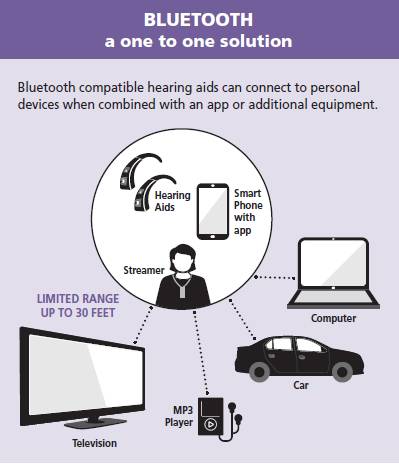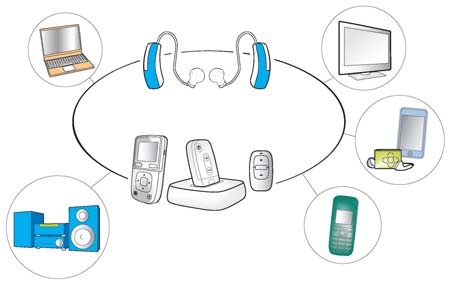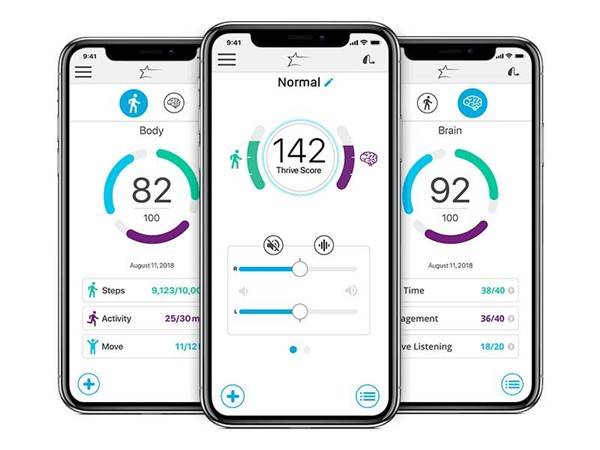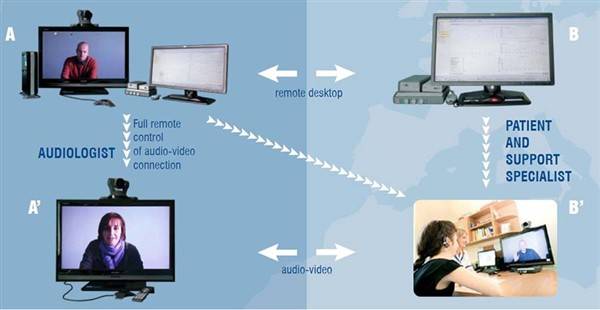Digital hearing aid technology is progressing quickly. Companies are introducing advanced features that offer users an amazing experience. Some of the digital hearing aid features are straight out of science fiction stories. You can have a phone conversation with your Bluetooth hearing aids, stay connected to communication devices and also get your health monitored.
We have covered some of the must-have basic features of digital hearing aids in our earlier article. In this article, we will discuss the features available in the Bluetooth hearing aids offered by hearing aid manufacturers.
Table of Contents
- Bluetooth Hearing Aids
- Artificial Intelligence in Digital Hearing Aids
- Internet Hearing Aids
- Tele-Audiology – A Helpful Digital Hearing Aid Feature
- Rechargeable Hearing Aid Feature
- Water Proof and Dust Proof
- External Accessories for Bluetooth Hearing Aids
- Automatic Program Change
- Invisible Digital Hearing Aids
1. Bluetooth Hearing Aids
This wireless connectivity feature in digital hearing aids is useful for people who rely on their mobile phones. For working professionals, using mobile phones is a big part of their daily routine whether they’re calling clients or having a conference call with teammates.
If you’re using a hearing aid without the Bluetooth feature, it can be difficult to converse comfortably using a mobile or cell phone. The hearing aid microphone also picks up surrounding noise, making it difficult to hear the person at the other end. It’s almost impossible if you’re in a public place with noise all around.
If you have purchased new hearing aids and are still struggling to get used to them, we advise you to read our article on 15 Helpful Tips For Getting Used To Hearing Aids.

Apple was the first to introduce the Made for iPhone Bluetooth connectivity protocol. Starkey was the first company to market the made for iPhone hearing aid. Currently, all companies offer the Bluetooth hearing aid feature.
Initially, cell phones working on the Android operating system could not benefit from this Bluetooth hearing aid streaming feature. Google’s Android phone operating system has finally caught up. GN ReSound in collaboration with Google introduced the first Bluetooth hearing aid which connects to Android phones.
What is Bluetooth LE or Bluetooth Low Energy?
Bluetooth consumes power and one has to replace hearing aid batteries often or recharge the batteries frequently. With the introduction of Bluetooth Low Energy technology or Bluetooth LE, the consumption will be reduced and the hearing aid user does not have to replace the batteries frequently.
However, the Bluetooth LE technology is yet to be introduced by hearing aid manufacturers though it is available in cell phones.
What is Bluetooth Auracast?
Bluetooth Auracast is the new technology from Bluetooth SIG. So far Bluetooth connectivity was only between two devices that were paired. The Bluetooth Auracast technology has made it possible to transmit the signal to all hearing aid users present within the range of the transmitter.
This will be a very convenient feature for people having Bluetooth hearing aids to attend lectures. The organizers have to provide transmitters at the venue and hearing aid users can select the Bluetooth feature on their phone and comfortably listen to the speaker.

Streamers were available before the launch of Bluetooth hearing Aids. Streamers are interfacing devices that make a non-Bluetooth hearing aid function like a Bluetooth hearing aid.
Connect the television sets, music systems, or iPods to the Streaming device with a connecting cord. The streamers relay to a receiving device which in turn connects to the hearing aid. The transmitter and receiver technology are proprietary, a hearing aid of one brand cannot be used with a streamer of another brand.
Streamline from Signia (Originally Siemens Hearing Aids). Surflink Media from Starkey and TV Streamer 2 from Resound are some of the streamers.
2. Artificial Intelligence in Digital Hearing Aids
Artificial Intelligence (AI) and Machine Learning (ML) are playing a role in all spheres of our life, can hearing aids be far behind? AI and ML play a very useful role in the new hearing aids and increase user acceptance and satisfaction.
Starkey has incorporated Artificial Intelligence in the Livio AI model. According to Starkey Laboratories, the Livio AI is the first digital hearing aid to integrate biosensors and Artificial Intelligence.
New Features in Starkey Livio AI:
The Biomedical sensors in the Livio AI are capable of measuring physical activity, calorie burning, heart rate, and blood pressure. Some of the latest features in Bluetooth Hearing aids are very useful.
The Bluetooth Hearing aid connects to the Starkey Thrive App. The App measures the daily activity and converts it into an easy to read Body Score. The App recommends achieving Body Score of 100 to stay fit. The App also provides an overall wellness score to indicate the state of Body and Mind wellness.
Brain Tracking
The App also calculates the benefits of using a hearing aid. The app calculates the total usage and benefits to the Brain.

Fall Detection and Alerts
The Livio AI has built-in sensors to detect if the hearing aid wearer has fallen. The App’s program sends alerts to the pre-selected contacts. A very important and useful feature for senior citizens staying alone.
Heart Rate Monitor
The Livio AI has a Heart Rate Monitor and alert system. It sends a message to a pre-selected number in case of any heart-related issue.
The Livio AI has a translation feature that currently translates into 27 languages. Set your language and the other person’s language. When you speak into the Thrive App, the App will convert your speech into text for the other person. Similarly, the App will translate their speech into your language and display the text. The displayed text is also converted to speech and streamed to your ears.
Tap Control
Stop or start the audio streaming to your ears through the Bluetooth hearing aids. You can pause the audio by double tapping the hearing aid to listen to someone talking to you. Double tap again and resume your music listening.
Other features like self-check or self-diagnostics, remote programming, transcription (saving speech to text) and find my hearing aids are very helpful.
3. Internet Hearing Aids
Digital Hearing Aids have joined the IoT devices (Internet of Things) list. Your digital hearing aids can stay connected to the internet through an App on your smartphone. The Oticon OPN is the first internet connected hearing aid. The Bluetooth hearing aid connects to the App on the phone. The App, in turn, connects to the Internet.
Advantages of Internet Hearing Aids
- Connect your Bluetooth Hearing Aid to the Doorbell. You will require an Internet doorbell for this purpose
- Control light switches using your Hearing Aids
- Serves as a warning system by connecting the Digital Hearing aid to the Fire alarm
- Stay connected to Social Media by connecting to Facebook, Twitter and other Social Media Apps.
- Connect to your Mail account and get mail alerts.
Oticon uses IFTTT (If This Then That) to enable the above features. IFTTT is a 3rd party App which triggers the function.
4. Tele-Audiology – A Helpful Digital Hearing Aid Feature

The use of the Internet is spreading rapidly. Every device or apparatus from a washing machine to home security is now connected to the internet. Audiological consultation has evolved from a face-to-face meeting to an online consultation and hearing aid fitting.
The basic Tele-Audiology method is in existence for some years. The Bluetooth digital hearing aid connects to the smartphone. The Audiologist remotely tunes the hearing aid through the App on the smartphone. Small adjustments and reprogramming is possible without the user visiting the Audiologist’s clinic.
- An online App on the Company’s website conducts the Hearing loss test.
- Select a suitable Hearing Aid
- Receive the pre-programmed Hearing aid
- Contact Support for adjustments
For more details read our article on the Latest Technology in Hearing Aids.
5. Rechargeable Hearing Aid Feature
Changing batteries is a cumbersome routine. Senior citizens with unsteady hands are dependent on others for this. Inserting the small batteries in CIC and IIC hearing aid is difficult for a person of any age. The latest offering from the companies has a rechargeable hearing aid feature. For more information, read this article on the Pros and Cons of Rechargeable Hearing Aids.
The Dutch company Widex has gone a step further and has announced a Fuel Mobile technology feature. Fuel mobile technology is the first in class digital hearing aid feature. As per the information released by Widex, this digital hearing aid does not require electricity. So, no searching for sockets to recharge if on the move.
The smallest commercially available fuel mobile fits into the digital hearing aid. A refill unit contains methanol. Methanol reacts with the air inside the fuel mobile to produce electric power. This 20 second process will supply power to the hearing aid for 24 hours.
6. Water Proof and Dust Proof
Water and electronics do not get along. All electronic devices need protection from water and dust. The humidity and dust damage the delicate miniature circuits inside the digital hearing aids. Exposure to water, humidity, and dust can lead to hearing aid malfunctioning.
Earlier, the manufacturers had a Nano coating on the hearing aid body. The coating made the hearing aid shell smooth and slippery. The water falling on the hearing aid rolls off and does not enter the gaps in the hearing aid body.
The manufacturers have now gone a step ahead, manufacturers are selling digital hearing aids which do not get damaged by water.
Digital hearing aids are now available with an IP rating. IP rating or Ingress Protection rating is an international quality standard. The number indicates the IP rating or the water and dust tolerance of the hearing aid.
- IP67 or Ingress protection 67
- IP68 or Ingress protection 68
Digital hearing aids marked as IP67 can resist water up to the depth of 1 meter for 30 minutes. IP67 also indicates 100% dust protection.
Similarly, IP68 can resist water up to the depth of 1 meter for 60 minutes. In case, you do not have waterproof hearing aids, read this blog on what to do if hearing aids get wet?
7. External Accessories for Bluetooth Hearing Aids
Thanks to Bluetooth Hearing aids, now connecting to external devices has become easy.
- Digital Hearing aids can now connect to Amazon Echo and other AI assistants through the smartphone App.
- Bluetooth Hearing aids streaming makes watching television or listening to music an enjoyable experience.
- Remote Mic is a useful accessory if you are attending a lecture, place the remote mic near the speaker. The remote mic pairs to the Bluetooth hearing aid for clear listening. The ReSound Multi Mic has a range of 80 feet.
- The remote control helps to change the program or the volume settings. The Hearing aid user does not have to struggle with the tiny buttons.
8. Automatic Program Change
The listening programs of digital hearing aids are for different situations or surroundings. Normal settings are “Speech in noise”, for use when one is outdoors. “Speech in quiet”, when one is at home or in a silent environment. And “Telephone Mode”, when one wants to talk on the phone.
Digital hearing aids have a push button to enable the user to change the program. At times this is inconvenient as one has to struggle with tiny push buttons. Very small in the ear digital hearing aids do not have any buttons or control. One has to use a remote control to make changes.
The latest digital hearing aids automatically change the setting without the user having to do so. The built-in software detects the situation and does the needful. The setting of the hearing aid changes to telephone mode as soon as the phone is brought close to the hearing aid or the ear.
9. Invisible Digital Hearing Aids
There are vanity issues and stigma attached to the use of hearing aids. A hearing aid user thinks that he or she will be considered deaf or old if seen using hearing aids. Strangely, it’s not the same with spectacles. Our hearing ability and eyesight weaken with age. Users can now choose small invisible hearing aids which are practically invisible.
Please note that the digital hearing aids style or the type has to be carefully selected. The style of the hearing aid should be as per the user’s lifestyle. Select the size and shape of the hearing aid according to your lifestyle and budget.
The use of hearing aids has a lot of advantages. Untreated Hearing loss leads to depression and other health issues. Do recommend the use of hearing aids for a better lifestyle.
About the Author

